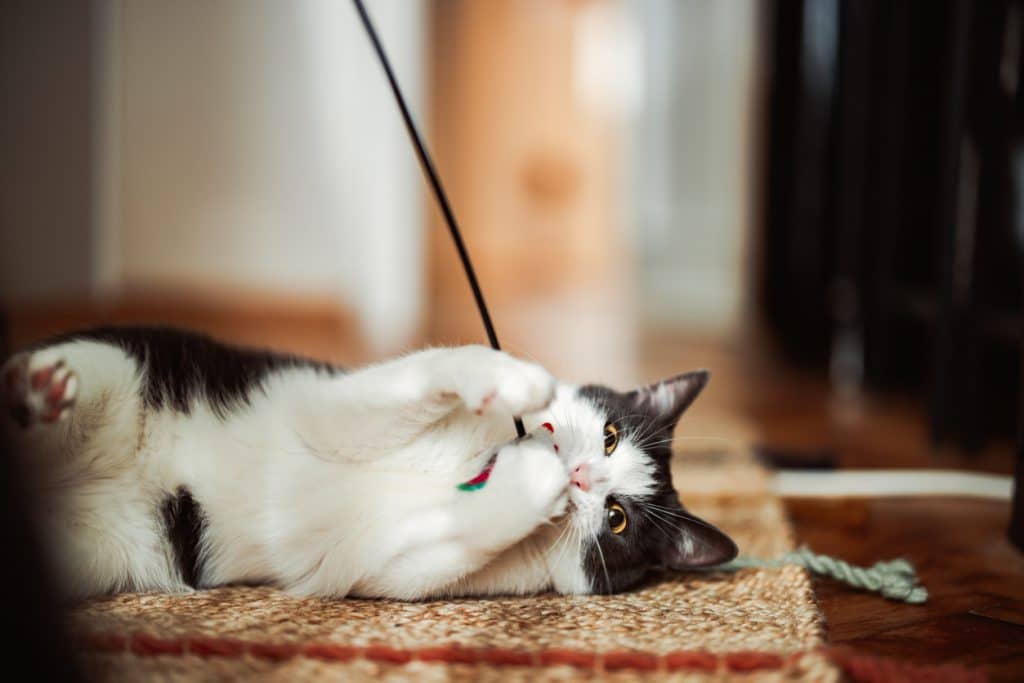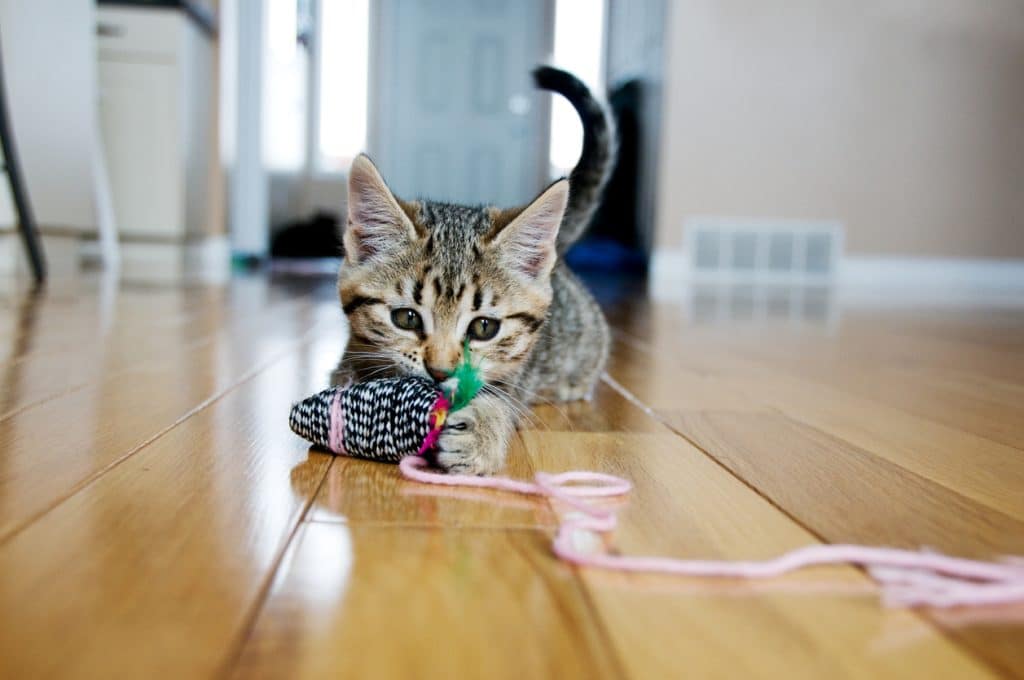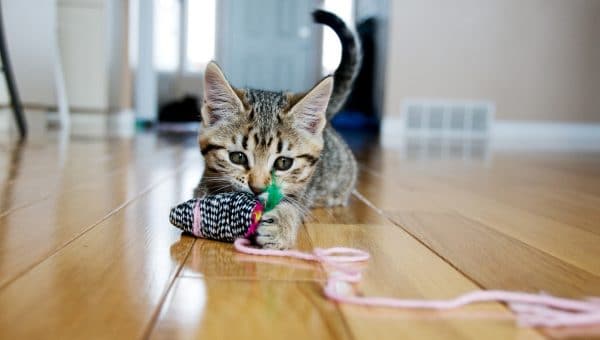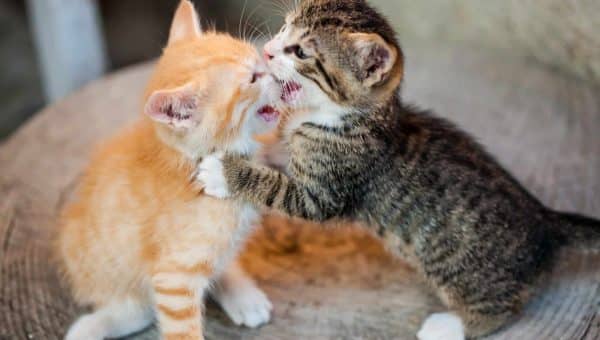Let’s face it, cats are weird. And, if you’re a cat parent, you know that our feline friends can exhibit strange behaviours—from knocking things off ledges to sleeping on your head! Ever played a lovely game of ‘nuzzle my head into your palm’ when wham, out of nowhere, your cat nips you? Then you, too, have probably wondered “why does my cat bite me?”
There are several reasons why cats bite—and a big one is play. Biting can be a common behaviour that is rooted in a cat’s natural instincts. “Cats bite for lots of reasons naturally—to kill prey, to play with littermates, and to protect themselves or fight,” says certified cat behaviour consultant, Dr. Mikel Maria Delgado, PhD.
With the help of Dr. Delgado, we’ll look at the different types of biting cats engage in and distinguish aggressive signs of affection, such as love biting, from when a cat bites out of aggression. Here’s what you need to know.
Why Is My Cat Biting Me?
Below, we’ll look at some different types of biting and why your cat may be exhibiting this behaviour.
Play Biting
Play biting is a very common type of biting and often serves as a way to release energy and can even relate to hunting instincts if, for example, you are playing with a wand, or another cat toy, that engages your pet’s prey drive.
However, this type of biting may also be a sign that you need to step up your quality playtime with your cat. “Cats are naturally predatory and need an outlet for that behaviour,” says Dr. Delgado. “If we don’t play with them enough, we can see them direct that predatory behaviour toward our hands or feet when they are moving.”
Love Biting
Love bites usually happen when you and your cat are otherwise being affectionate. It’s a nip, and in most cases, it doesn’t break the skin. It might start out with licking before you feel the graze of teeth against your hands. In other words, your cat won’t be showing you any other signs of aggression—they won’t be hissing or clawing at you or trying to get away.
But a ‘love bite’ might indicate that your cat no longer loves the fuss they are receiving from you. “It is likely that a cat is getting overstimulated from the attention and pets, and, although they might be enjoying it, it is simultaneously overwhelming,” says Dr. Delgado. It’s not personal, they just need a break!
Biting for Attention
Sometimes a cat bites you, not because they’re in the throes of play, or because they’re overstimulated by affection, but because your cat is literally saying “hello!” to you and trying to get your attention.
“Cats can learn that if they nip at you, you respond or give them attention,” says Dr. Delgado. Like most negative attention-seeking behaviours, it is best not to reward attention-biting. Don’t react; walk away, and attempt to redirect your cat to a toy.

iStock/miniseries
Sudden Biting While Petting
Ever been ambushed while petting your cat or even just walking in your house? This out-of-nowhere biting can be confusing but may have a few explanations.
Bummer fact: not all cats enjoy being petted, and some cats have areas of their body that they don’t like having touched, like their bellies or near their tail. In this case, it’s best to focus on “safe” areas of the body for your cat. “Most cats prefer gentle petting to their cheeks and head, and are less likely to appreciate petting on the base of the tail or belly,” says Dr. Delgado. “Every cat is different, so it’s important to get to know your cat to figure out what they like. If you don’t know a cat well, stick to the safer gentle cheek rubs!”
Kitten Biting/Teething
What can we say? Teething happens. According to Dr. Delgado, teething occurs between three weeks to six months of age.
Although this is a stage every young kitten will go through, this biting behaviour is rarely directed at people. “[Kittens] rarely bite humans because of teething. They are more likely to chew on items or paw at their mouths,” says Dr. Delgado.
Aggressive Cat Biting
Dr. Delgado explains that the ‘why’ behind aggressive biting is important. “I don’t describe biting as ‘aggressive biting’. There are many reasons that cats may display aggressive behaviours,” says Dr. Delgado.
Fear can also be a factor in your cat’s biting. “Cats may also bite when they feel threatened or cornered. That is often accompanied by swatting, ears back, hissing, and trying to protect themselves from the threat,” says Dr. Delgado.
Redirected aggression happens when your cat was previously aroused by something they couldn’t get to, like an animal outside the window, and then they ‘redirect’ that arousal at you (or another pet) by being aggressive. It’s common, and the attack can happen even hours later.
If that sounds like your cat, you’ll need to seek out a veterinary behaviourist to see if you can course-correct so that you and your pet can make peace. The sooner, the better. Punishing an aggressive cat won’t work—it’s best to avoid escalating the situation.

iStock/Rawpixel
How Do I Stop My Cat From Biting?
When it comes to cat biting, there are a few different approaches. Dr. Delgado recommends the following
- Make sure to give your cat plenty of things to keep them busy, such as solo play toys, scratching posts, and food puzzles
- Be sure to play with your cat with interactive toys every day
- Handle your cat gently, and never roughhouse with them, as that encourages them to bite and scratch
- Talk to your veterinarian or a behaviour professional if you are having concerns about your cat’s biting or scratching
Additionally, avoid bare hands and feet during playtime and, when biting happens, avoid punishment and focus on praising your cat for good behaviour.
How To Tell If My Cat Is Going To Bite
Though a bite may seem like it’s coming out of nowhere, cats, in fact, have their own body language to indicate the potential of an oncoming bite. Here are some signs to watch for, says Dr. Delgado:
- Increased vocalisations, or a ‘cranky meow’
- Turning their head to look at your hand
- Ears might move backwards, sideways, or flatten out
- Flicking or lashing the tail
- Skin twitching
- Pupils might dilate or look like slits
- Claws might come out
- Whiskers moving forward
- Stiffening leg or shoulders, or muscle rippling
- Raised paw
- Moving their body away
Remember that no two felines are the same; cat bite-indicative body language may vary.

iStock/Wildroze
What Should I Do If My Cat Bites Me?
If your cat bites you, but it doesn’t break the skin, then it does not necessitate medical attention. In this case, you’ll want to figure out what’s causing the behaviour. “If your cat bites you, stay calm and do not punish or yell at them. It will only increase their fear or stress,” says Dr. Delgado. “Instead, try to figure out why your cat bit you—what you were doing and what body language they were displaying. Try to avoid that situation in the future. Most cat bites occur on human hands in response to being handled, often in a way that was stressing the cat out.”
If the bite does break the skin, irrigate the area heavily with water immediately, and a saline solution, if available. If the bleeding hasn’t stopped, you can compress the area, but it’s important to see a doctor ASAP. According to Dr. Delgado, these wounds can become easily infected.
Cats have a lot of unfriendly bacteria in their mouths—including Pasteurella, Streptococcus, Staphylococcus, and more—and a bite can transfer these species of pathogens to humans, possibly causing flu-like symptoms, fever, and even death (though this is very rare). Young people, old people, and folks who are already ill or immunocompromised are most at risk.
Your doctor will likely have to file a report based on the bite. If your cat isn’t current on their rabies vaccinations, they may need to be quarantined for a short time. In the scenario of frequent bites, or bites that break the skin, it’s important to consult a veterinary behaviourist to address the problem as soon as possible.
How To Pet A Cat
One crucial way to avoid a cat bite is know how to pet a cat in the first place. But what is the proper way to pet a cat? Dr. Delgado has the following tips:
- Let a cat approach you, or offer a finger and let them sniff or rub into it
- Cats prefer to be in control of interactions, and most cats will prefer shorter, more frequent interactions than a longer petting session
- Avoid sensitive areas, like the belly and tail base. As mentioned above, head and cheek rubs are usually safe!
- Pet gently in the direction that their fur lies (don’t ruffle their fur while petting, as that may be irritating)
Takeaway
It’s important to pay attention to your cat’s body language. And while hissing, flattened ears, stiffening, etc. can be negative signs indicating a need for clear boundaries, it’s also good to know your cat’s positive body language in order to nurture a happy and healthy relationship between you. “Cats who are enjoying petting may rub into your hand, purr, close their eyes, knead their paws, and lay on their side,” says Dr. Delgado. As any cat parent can tell you, once you hear that motor-like purr, you know you’re heading in the right direction!




